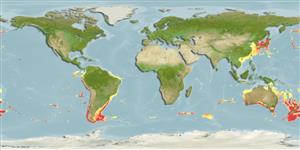Common names from other countries
Environment: milieu / climate zone / depth range / distribution range
Écologie
; profondeur 32 - 1700 m (Ref. 1456). Temperate
Distribution
Pays | Zones FAO | Écosystèmes | Occurrences | Introductions
Indo-West Pacific and the Antarctic.
Length at first maturity / Taille / Poids / Âge
Maturity: Lm ? range ? - ? cm
Minimum depth from Ref. 87801. This deposit and suspension feeder is found on stones, rock and mud (Ref. 87801), at depths of 32 to 1700 m on a seamount (Refs. 80485, 87801).
Life cycle and mating behavior
Maturité | Reproduction | Frai | Œufs | Fécondité | Larves
Members of the class Ophiuroidea are mostly gonochoric, others are protandric. Fertilization is external. Brooding is common, bursae is used as brood chambers where the embryos develop into juveniles and later crawl out from the bursal slits. Life cycle: Embryos hatch into free-swimming planktotrophic larvae and later metamorphose into tiny brittle stars which sink down the bottom where they grow into adult form.
Census of marine life's education and outreach team. 2008. (Ref. 80485)
Statut dans la liste rouge de l'IUCN (Ref. 130435)
statut CITES (Ref. 108899)
Not Evaluated
Not Evaluated
Menace pour l'homme
Harmless
Utilisations par l'homme
| FishSource |
Outils
Plus d'informations
Taille/ÂgeCroissanceLongueur-poidsLongueur-longueurMorphologieLarvesAbondance
Sources Internet
Estimates based on models
Preferred temperature
(Ref.
115969): 1.3 - 11.8, mean 7 (based on 491 cells).
